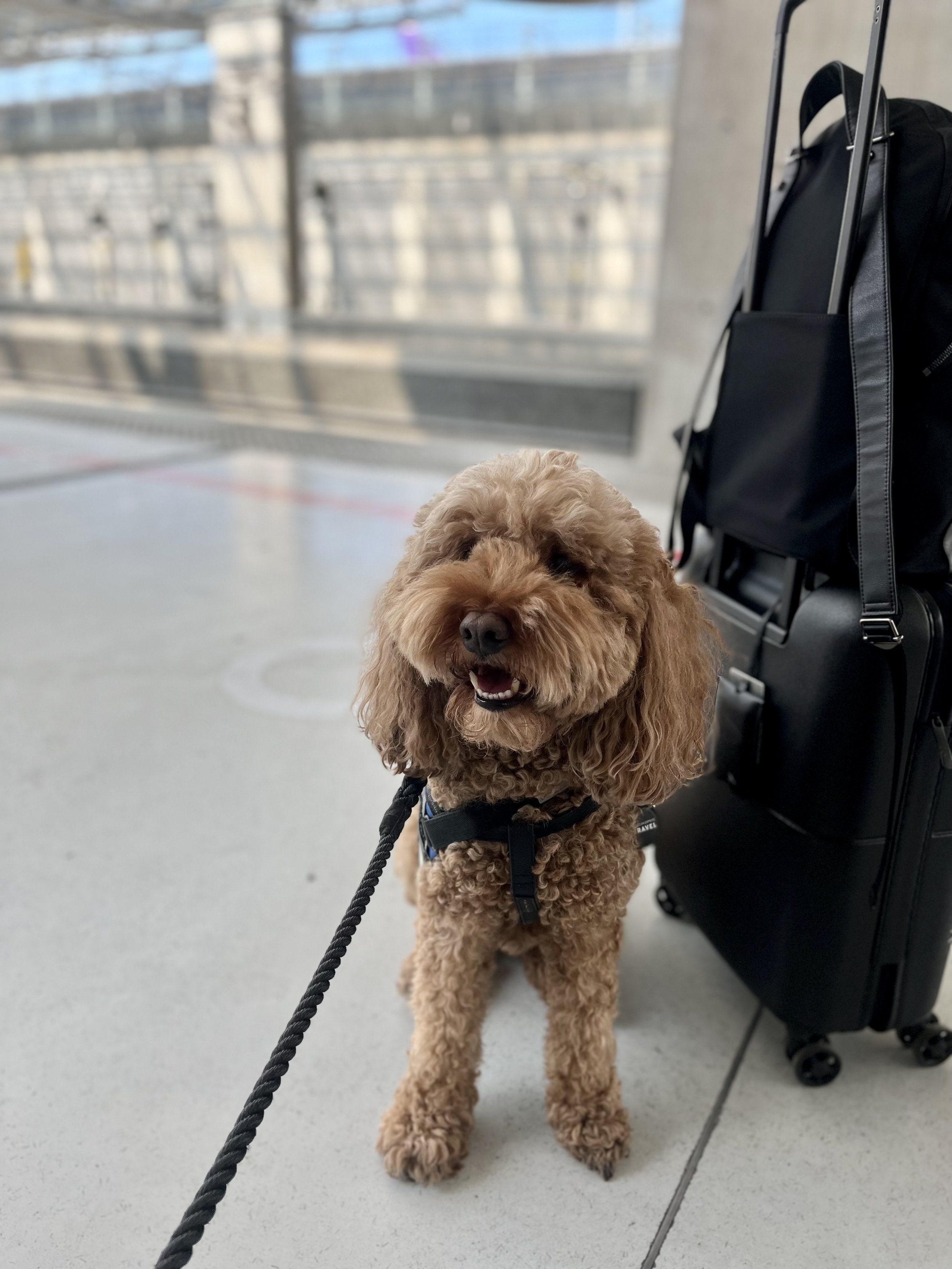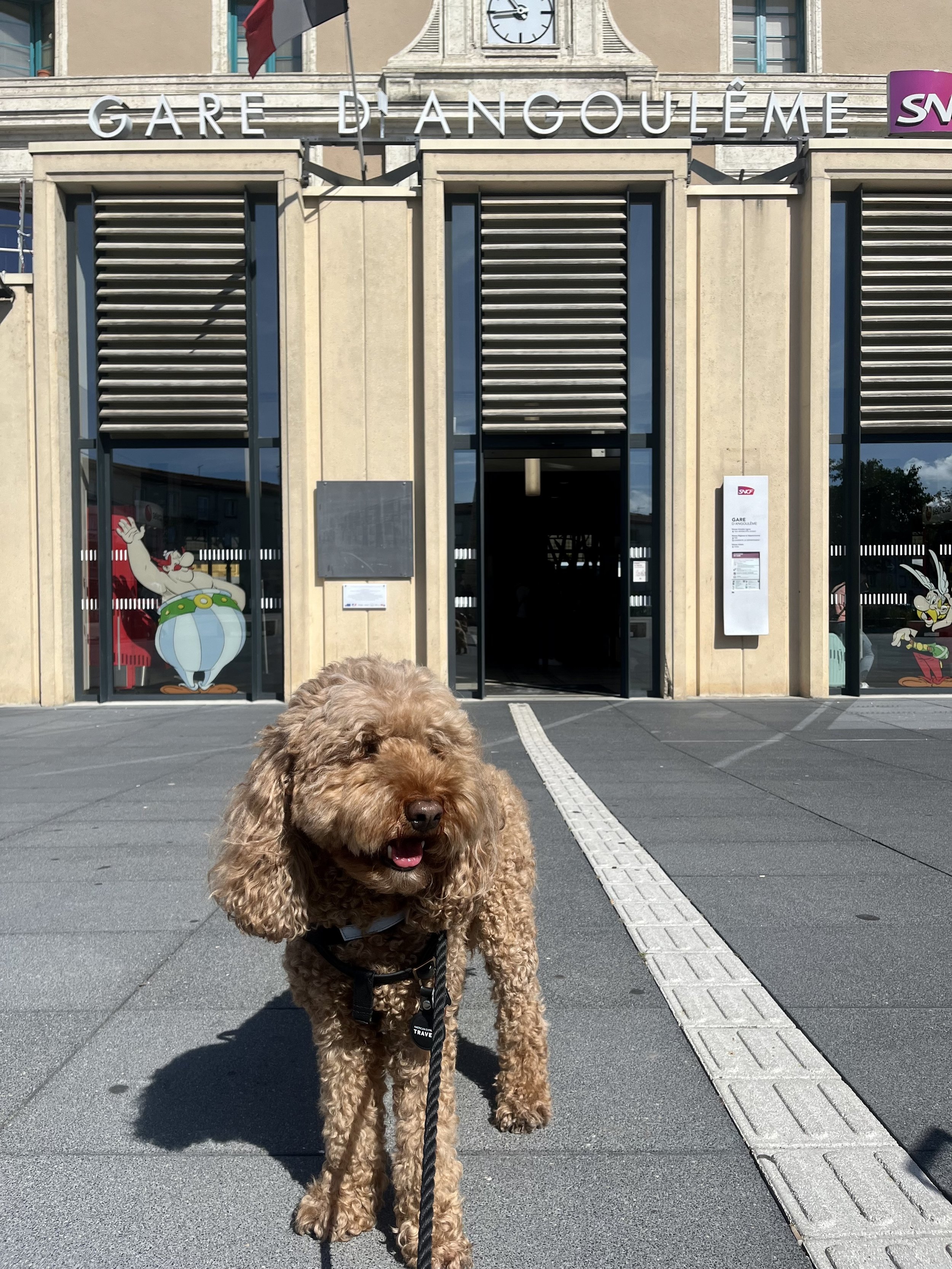How to Travel With Your Dog on France’s High-Speed Rail Train
Dash at the train station at Paris-CDG Airport
There’s no better way to see Europe than by train, and for us dog lovers, there are few lifeforms better to travel with than your pet.
Traveling with a dog on France’s high-speed rail, the TGV (“Train à Grande Vitesse” en Français) can be a delightful (and easy) for both of you with a little planning in advance.
Whether you're planning a vacation or simply moving between cities, the TGV provides a convenient and comfortable way to explore France with your pet by your side. Here's what you need to know to ensure a smooth journey.
Booking Your Tickets
When booking your TGV tickets, it's essential to include your dog in the reservation. Small dogs weighing up to 10 kg (about 22 lbs) can travel in a carrier on your lap or under your seat, and they require a ticket that costs a flat rate of €7. Larger dogs over 10 kg must have a ticket, which costs 50% of the second-class fare, regardless of the class you're traveling in.
Service animals travel free, although you should have some paperwork and/or identification proving this in case the conductor asks when scanning your tickets. Service animals also do not need to wear a muzzle or be transported in a carrier. It is recommended you do have a vest designating their job so other people are aware and do not try to pet your dog or get in the way otherwise.
For people traveling with pets (non-service animals), you can purchase your pet's ticket online when you book your own or at the station. Make sure to bring a printout of the ticket, as you'll need to present it during your journey.
Dash at the train station in Angoulême
Preparing for the Journey
Before embarking on your TGV adventure, ensure your dog is comfortable with train travel. Traveling with them on a local subway (if available) or even just by car is a good start.
Familiarize them with their carrier or leash and give them plenty of exercise before the trip. This will help them settle down more easily during the ride.
Pack a small bag with essentials such as:
Bottled water and a collapsible/portable bowl: Keeping your dog hydrated is crucial, especially on longer journeys. And there might not be water fountains on the train or at the station.
Snacks or a light meal: Bring along some of their favorite treats or a small meal for longer trips.
Leash and harness: Even if your dog will be in a carrier, you'll always need a leash and harness for moving through the station. It’s mandatory.
Waste bags: Clean up after your dog at the station or any stops along the way.
Comfort items: A favorite blanket or toy can help your dog feel more secure during the trip.
Boarding the TGV
Arrive at the station with enough time to navigate through the crowds, especially if your dog is not accustomed to busy environments. If your dog is in a carrier, make sure it's well-ventilated and the right size for your dog to stand, turn around, and lie down comfortably.
In case you’ve never taken the train in France before, you should familiarize yourself with your own ticket—specifically the train car (voiture) and seat (siège). There will be a map on the platform that will help you determine where you should wait and then board once the train arrives. The trains do run on time in France, so you need to board quickly. The train will not wait for you.
After boarding the TGV and finding your seat, the train conductor usually comes through the car while in transit. You will defintely need to show your own ticket, and you may need to show your dog's ticket to the conductor. If your dog is larger, they'll need to be on a leash and wear a muzzle throughout the journey, as required by French law for larger dogs in public spaces.
During the Journey
Once on board, find your seat and make your dog comfortable. If your dog is in a carrier, place it in a secure spot where it won't move during the trip. Larger dogs should sit on the floor near your feet.
The TGV is a relatively quiet and smooth mode of transport, which can be calming for pets. However, it's essential to keep an eye on your dog and offer reassurance if they seem anxious. Taking a few short walks within the train car, if permitted, can help stretch their legs and reduce restlessness.
Arriving at Your Destination
Upon arrival, take your time disembarking to avoid rushing through the station. If you’re at the end of the line and not in a rush, consider waiting until everyone in your car has left and then you both can exit calmly. Give your dog a chance to relieve themselves after the journey, especially if it's been a long trip. Many stations in France have designated pet relief areas, so look for signage or ask station staff for assistance.
More Tips for a Stress-Free Experience
Choose quieter travel times: If possible, book your journey during off-peak hours to avoid crowded trains and stations, making the experience less stressful for your dog.
Plan for breaks: If your journey is long, consider breaking it up with stops in pet-friendly cities where your dog can have a proper walk and rest.
Respect fellow passengers: Not everyone is a dog lover, so ensure your dog is well-behaved and doesn't disturb other passengers.


